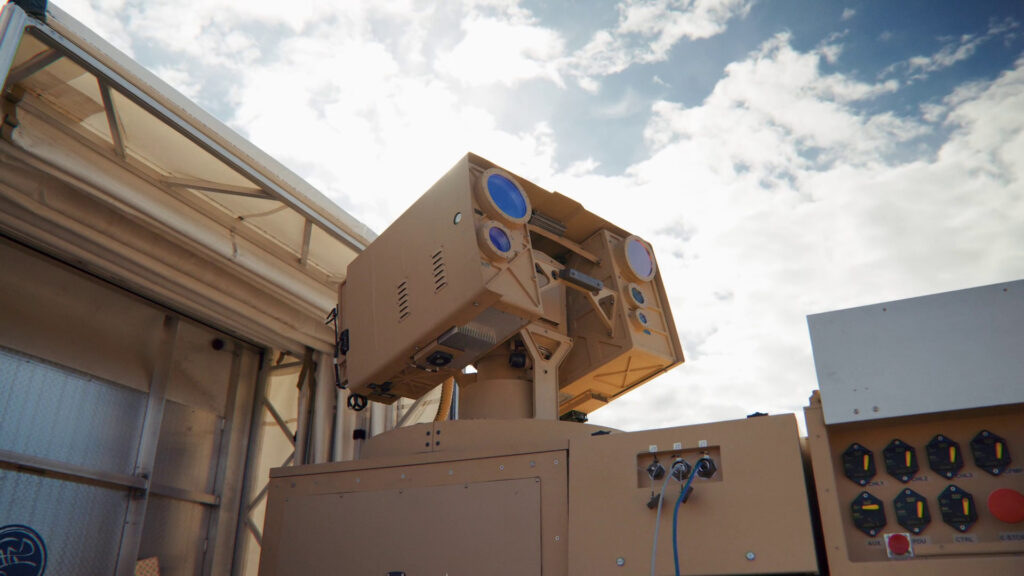
By Richard R. Burgess, Senior Editor
ARLINGTON, Va. — BlueHalo will be testing its LOCUST Laser Weapon System on a U.S. Marine Corps Joint Light Tactical Vehicle (JLTV), the company’s chief executive officer (CEO) said.
BlueHalo’ s primary focus is on defeating Group1, 2, and 3 unmanned aerial systems (UAS), as well as counter-rocket and counter-mortar systems, said Jonathan Moneymaker, CEO of Blue Halo, in an interview with Seapower.
“As the foundation of P-HEL, BlueHalo’s LOCUST Laser Weapon System (LWS) combines precision optical and laser hardware with advanced software, artificial intelligence (AI), and processing to enable and enhance the directed energy “kill chain,” the company said in a release. “LOCUST LWS addresses the inherent need for mobility and quick deployment–tracking, identifying, and engaging of a wide variety of targets with its hard-kill high energy laser.
“We look at it from an integrated layered defense strategy,” Moneymaker said. “Five years ago, we saw the evolution of drone warfare, today one of the fastest-evolving threat vectors. We wanted to engage that from a variety of modalities. We offer solutions and products that range from passive detection in our Skyview product to RF detect-and-defeat in our Titan product, our LOCUST Laser Weapon System, expanding into more global C2 [command and control], and starting to expand into our next-gen kinetic interceptor.
As of April 2024, BlueHalo had delivered two P-HEL systems to the U.S. Army, which has deployed them to unspecified locations.
“It is most certainly [deployed] in areas of conflict,” Moneymaker said. “It’s real, it’s deployable, it’s reliable, and frankly needed to bring service members home.”
“We’re very proud to be the first operationally deployed [HEL] system,” Moneymaker said, noting that its system has surpassed operational 10,000 hours and that the customer having a system that “has finally reached a level of reliability that they’ve been looking for as they’ve been fielding these capabilities.”
He said that the next expansion would be a mobile high-energy laser weapon — on an infantry squad vehicle or a JLTV. The first mobile system was delivered in late March.
“The JLTV integration will be on the Marine Corps’ JLTV, so we’ve been working with all of the services as it relates to deployment of LOCUST,” he said. “We certainly have been having initial conversations with afloat Navy on how can we deploy these systems in the best configuration to counter some of the activity we’re seeing in the Red Sea.”
Moneymaker said he sees great potential in the “proven, ready [P-HEL] system” for naval use with its roll-on/roll-off capability.
The work for the Marine JLTV is through the Department of the Navy’s Ground-Based Air Defense program, as well as through the Joint Capabilities Office and U.S. Army Rapid Capabilities and Critical Technologies Office (RCCTO).
Moneymaker said the LOCUST is very effective against a [drone] swarm, noting that the capability is part of the test criteria. The LOCUST uses Wizard artificial intelligence and machine learning for target identification and aimpoint recognition.
The P-HEL is powered by a generator or batteries, and the company is looking at how to tie the HEL into shipboard power.
The company’s HEL is built primarily at the BlueHalo campus in Albuquerque, New Mexico, with work expanding to Huntsville, Alabama, and Rockville, Maryland. BlueHalo, headquartered in Arlington, Virginia, employs 2,400 workers and is approaching revenue of $1 billion annually. The company has other facilities in Dayton, Ohio, and Fort Lauderdale, Florida.
- SAIC Advances Scalable Open-Architecture Counter-UAS Systems - May 9, 2024
- Navy’s Triton UAV to Provide Targeting for LRASM - May 2, 2024
- BlueHalo to Test C-UAS System on Marine Corps JLTV - April 29, 2024



